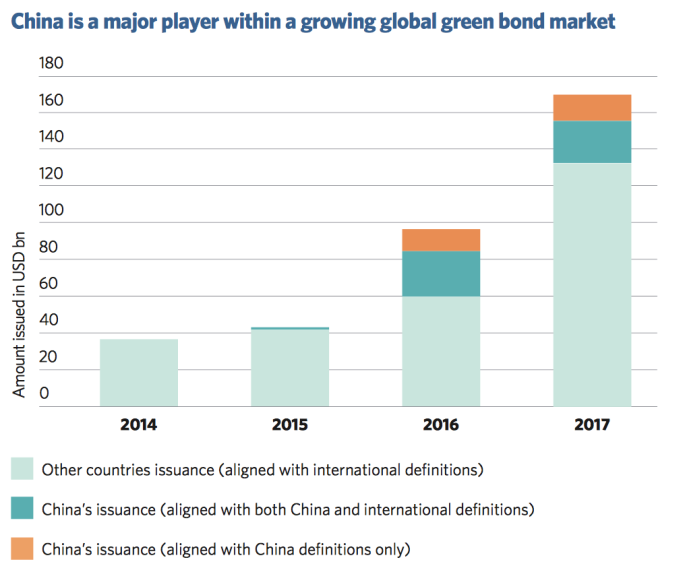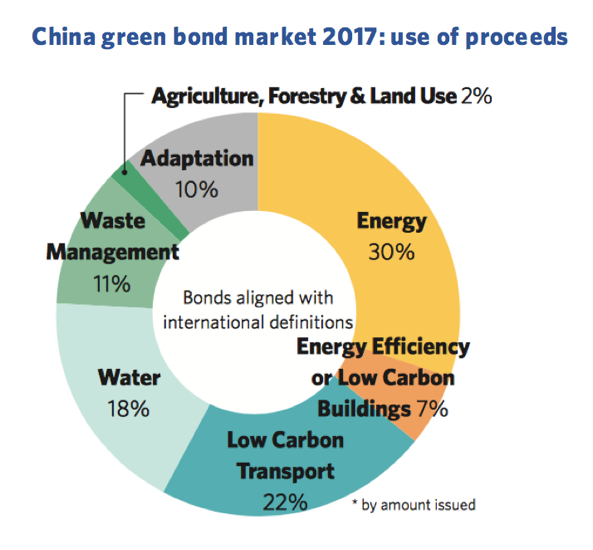-
China’s Green Bonds Finance Climate Resilience

In 2014, we met with some of the technical leads of a major Chinese river basin authority in Beijing and asked them whether they were more worried about pollution or climate change impacts. Both, the engineers replied. Pollution affects us every day, they said, but changes in the climate erode our ability to supply drinking and irrigation water, manage floods, and generate electricity.
China must address its environmental and climate change challenges, such as reducing water pollution and building resilience to droughts, floods, and long-term climate shifts. But existing sources of finance have not met the growing demand for environmental projects. The rapid growth of the green bond market offers an opportunity to mobilize private capital for resilient investments. However, to ensure credible market growth, we need evidence-based green standards and transparent criteria. A new set of standards—Climate Bonds Standard’s Water Criteria—are designed to support this emerging green bond market in China.
China Is Moving From Rapid Growth to Green Growth
Over the past three decades, China has become an economic powerhouse, making impressive investments in water to fuel growth in energy, cities, and food, and to increase disaster security and manufacturing. This growth, coupled with rapid climate change, has overtapped and polluted China’s water, leaving water-dependent infrastructure high and dry.
The Chinese government has made ambitious statements about reducing national greenhouse gas emissions to slow the rate of global climate shifts. While decarbonizing a large and rapidly growing economy presents significant risks, a second threat arises from making investments in infrastructure that is not climate resilient. The water cycle is particularly sensitive to climate change, making it increasingly difficult to plan, design, and manage water investments when systems are designed to reflect the past rather than to prepare for the future.
Water Infrastructure Is Thirsty for Investment
As political and social pressures for more effective and resilient water infrastructure grows, the funding gap becomes more glaring. The investment in infrastructure required by China’s urbanization and economic growth is estimated to be $6.74 trillion between 2014 and 2020. The People’s Bank of China estimated that an annual investment of at least US$320-640 billion will be required to specifically address environmental and climate change issues.
China’s investment in wastewater treatment, flood defense, and ecological restoration has been increasing annually: From 2011 to 2015, the investment in water infrastructure amounted to $310 billion, an average of $62 billion a year, and in 2016, investments reached more than $90 billion.
These investments in water infrastructure are expected to continue to increase, due to China’s plans to address water pollution and its long-term plans to secure its water supply, reduce degradation of its hydrological environment, and increase resilience to droughts and floods, as outlined in the Water Pollution Control Action Plan and Water Resources Development and Reform 13th Five Year Plan (FYP).
However, even with increased investment, traditional sources of capital for infrastructure development, such as government and bank finance, are insufficient; they are only able to contribute 15 percent of the capital required for environmental and climate change solutions.
Mind the Gap: China Is a Green Bonds Pioneer
Institutional investors are increasingly filling these financing gaps. Green bonds—which are the ideal vehicle for filling funding gaps and promoting water sustainability—have become a valuable tool. Currently, they account for less than 0.2 percent of all bonds issued globally and only 2 percent in China, but their growth has been record-breaking.

China’s total green bond issuance in 2017 reached US$37.1 billion (RMB 247.8 billion) in 2017—an increase of 4.5 percent over 2016. China is now the second largest green bond issuer after the United States, spurred by a combination of policy development, growing momentum at the local level, and the diversification of issuer types and use of proceeds. Approximately 15 percent (US $7.1 billion) of the proceeds from green bonds have been allocated to a variety of water projects, including wastewater treatment, silt removal, water resource management, and ecological restoration.

Standards Provide Credibility for Water and Climate
However, the rapid growth in the green bond market has spurred questions about the environmental claims of these bonds, both globally and in China. In the absence of clear and widely accepted standards, many investors have raised concerns about “greenwashing,” a practice in which bond proceeds are allocated to assets that have little or unclear environmental value. This lack of certainty shakes confidence in the market and hampers efforts to finance the transition to a low carbon economy.
To address the issue of greenwashing within water infrastructure investments, a consortium of NGOs developed the Climate Bonds Standard (CBS) Water Criteria. The CBS Water Criteria define low carbon and climate-resilient water infrastructure by evaluating the impact of water-related investments on climate mitigation and climate adaptation. The criteria provide guidance on the types of water projects that should be included in green bonds, including infrastructure for water capture and collection, water storage, water treatment, flood and drought defense, stormwater management, and ecological restoration and management. The criteria also include both built and nature-based water infrastructure, such as rivers, lakes, natural watersheds, and aquifers.
The Water Criteria’s certification scheme requires an independent “Approved Verifier” to assess green bonds. The verifier’s assessment indicates to investors that the underlying water assets have undergone environmental due diligence, thus enabling investors to more easily identify and invest in water infrastructure with genuine climate benefits.
To date, green bonds worth more than $1 billion from San Francisco Public Utilities Commission and the city of Cape Town have been certified under the CBS Water Criteria. Following the release of full criteria in March 2018, we expect more certified green bonds from issuers throughout China, mobilizing more capital for water investments with clearly defined environmental benefits.
Lily Dai is a Senior Research Analyst at Climate Bonds Initiative.
John Matthews is the lead for AGWA: the Alliance for Global Water Adaptation, based in Corvallis, Oregon.
Sources: Climate Bonds, Finance China, Investopedia, Ministry of Environmental Protection, Ministry of Water Resources, Natural Development and Reform Commission, New Climate Economy, World Bank
 A Publication of the Stimson Center.
A Publication of the Stimson Center.





